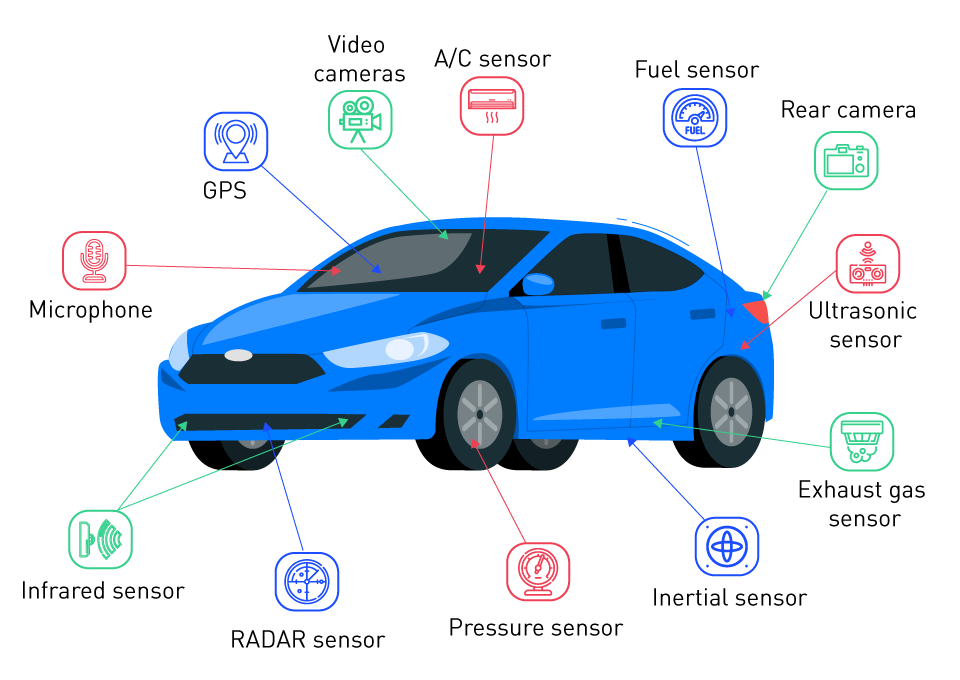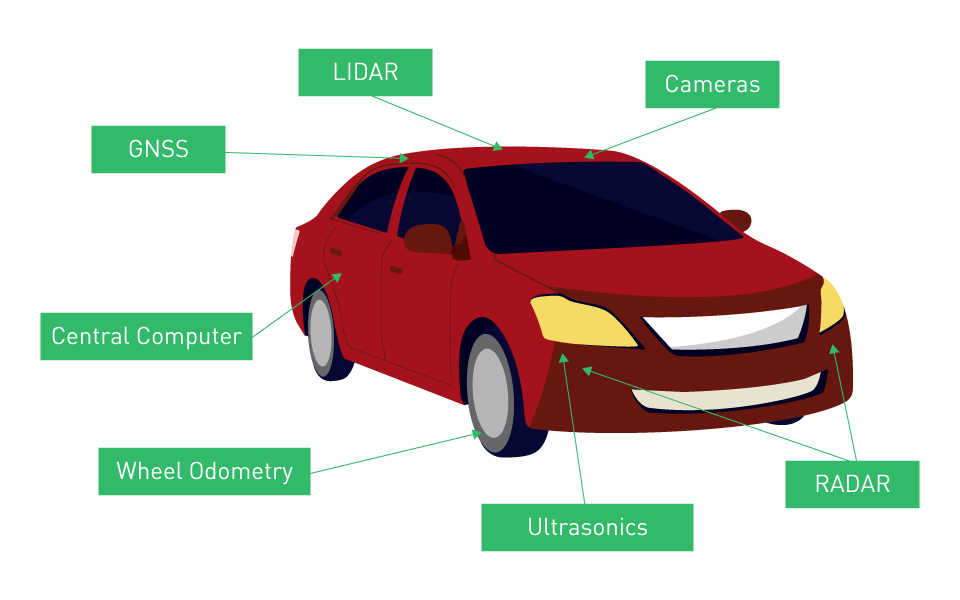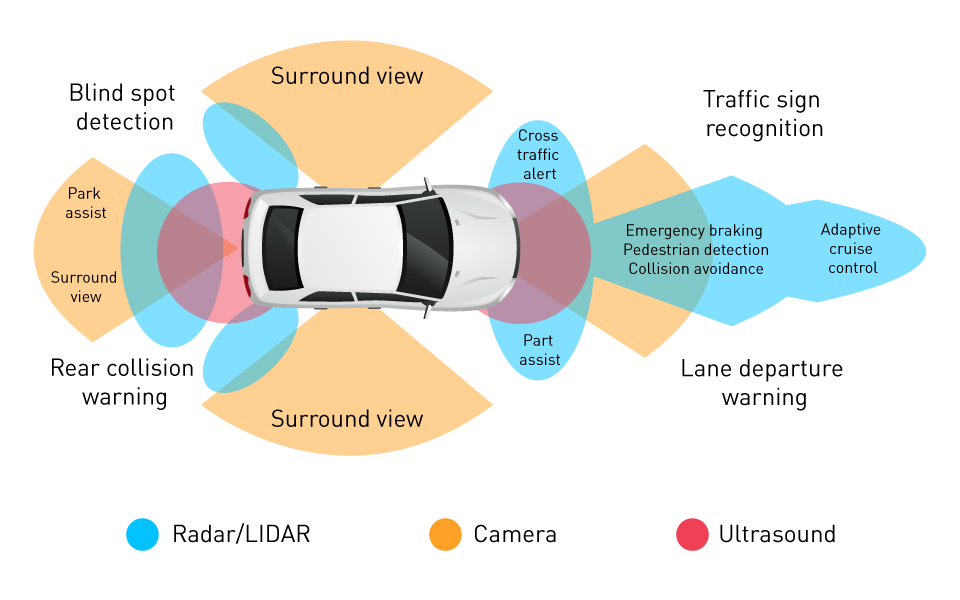Introduction to Modern Automotive Systems
Over the years, the integration of sensors into automotive systems has undergone a radical metamorphosis, progressing from simple mechanical components to complex, intelligent electronic gadgets. This section explains how sensors have evolved and played a crucial role in cars, enabling improvements in automation, performance, and safety.
Evolution of Sensors in Vehicles
When the automobile industry was just getting started, most cars were mechanical machines without complex electronic control systems. The majority of the time, sensors were only used in simple equipment like fuel gauges and speedometers, which were meant to give drivers minimal information.
Mechanical Era: Manual operations and analog systems were hallmarks of the automobile throughout this period. During this time, the sensors were mostly confined to sensing temperature, speed, and fuel level. They were also simplistic and had limited functionality.
Electronic Era: The introduction of Electronic Control Units (ECUs) to the automotive industry marked the beginning of the electronic era, which turned cars into a symphony of interconnected electronic systems. Sensors became essential, giving real-time information on ambient factors, vehicle speed, and engine characteristics. This helped with improved safety features and optimal vehicle control.
Intelligent Sensor Era: In the modern era, sensors that are embedded with microprocessors and communication capabilities have become commonplace. These sensors are essential to the development of autonomous driving, advanced driver assistance systems (ADAS), and vehicular communication systems in contemporary automobiles. They support a variety of functions, such as navigation, health monitoring, parameter control, and occupant safety and comfort.

Figure 1: Electronic Sensors in Vehicles
Autonomous Era: Autonomous cars are expected to be self-sufficient and capable of autonomous decision-making and environmental navigation. This era is rapidly approaching. The key component of this transition is the sensors, which provide the car with the capacity to sense, comprehend, and communicate with its environment. This allows for the implementation of sophisticated features like autonomous parking, adaptive cruise control, and lane-keeping assistance.

Figure 2: Autonomous Vehicle Sensors
The collaboration of many sensor technologies, such as LIDAR, RADAR, ultrasonic sensors, and cameras, is essential in this autonomous landscape to build a thorough and accurate perception of the surroundings, which is required for secure and dependable autonomous navigation.
The development of sensors in automobiles is an evidence of the industry's unwavering commitment to innovation, which has fueled improvements in automation, efficiency, and safety. Sensors have influenced the course of automotive development, from simple mechanical parts to complex intelligent systems, opening the door for a world of connected, autonomous, and smart automobiles. The ongoing development and integration of sensor technology will support a more sustainable, effective, and secure mobility ecosystem, ushering in new paradigms in vehicle design and operation.
Steering, Power Systems, and Drive Controls
For improved vehicle performance, safety, and efficiency, different sensors must be included in drive controls, power systems, and steering in current automotive applications. These sensors enable accurate monitoring and control, guaranteeing the car runs as well as it should.
Role of Angular Position Sensors, Current Sensors, and Accelerometer
Angular Position Sensors: These sensors play a critical role in steering systems by giving vital information on the steering wheel's rotational position, which is necessary for controlling the vehicle. They make it possible to accurately ascertain the angular displacement of the wheel, providing crucial information about the steering input and the wheel's corresponding response. This permits real-time steering angle modification.
When using cutting-edge steering technologies like Electronic Power Steering (EPS), these sensors are essential because they give control units feedback that allows them to adjust the assistance level in response to the driver's input, improving steering precision and responsiveness.
Current Sensors: Current sensors have a big impact on drive controllers and power systems. They keep an eye on the electric current flowing through the car's electrical systems and provide data in real time to improve energy use and guard against overcurrent situations. Current sensors are essential for checking the battery's condition, distributing energy efficiently, and protecting the battery from overcharging or discharging in electric vehicles (EVs) and hybrid electric vehicles (HEVs).
Accelerometers: Used in many automotive applications, accelerometers monitor the rate at which a vehicle accelerates, either as a result of internal combustion engines or external forces. They are essential parts of electronic stability control (ESC) and traction control systems (TCS), which use them to monitor the dynamic state of the car and send control units feedback to keep wheels from slipping and improve stability.
Accelerometers work with gyroscopes to form Inertial Measurement Units (IMUs), which are necessary for maintaining vehicle balance and stability, particularly in off-road and high-performance vehicles. IMUs provide detailed data on the motion and orientation of the vehicle.
Applications in Advanced Driving Systems
The core components of sophisticated driving systems are accelerometers, current sensors, and angular position sensors. These components enable smooth communication between the driver and the car and guarantee the safe and effective operation of the vehicle. In order to realize advances in vehicle technology, such as autonomous driving and intelligent transportation systems, and to pave the way for a future with safer and more sustainable mobility options, their synergistic functioning is essential.
The integration of accelerometers, current sensors, and angular position sensors in drive controls, power systems, and steering embodies the modern automobile design trend of combining mechanical and electronic systems. The monitoring, control, and feedback systems play a crucial role in improving the efficiency, safety, and performance of vehicles. This, in turn, contributes to the continuous growth of the automotive landscape. Future automotive systems are expected to have even greater capacities and functionalities because of the ongoing improvements in sensor technology.
Advanced Driver-Assistance Systems (ADAS)
The goal of Advanced Driver-Assistance Systems (ADAS) is to improve driving safety and overall vehicle operation. It is a major advancement in automotive technology. These systems help the driver navigate and react to different driving situations by using a variety of sensors, such as LIDAR, RADAR, cameras, and ultrasonic sensors, to sense the environment surrounding the car.
Utilization of LIDAR, RADAR, Cameras, and Ultrasonic Sensors
LIDAR: Light Detection and Ranging (LIDAR) sensors use laser beams to measure object distances and create intricate three-dimensional maps of an object's surroundings. Even in low-visibility situations, LIDAR is an excellent tool for determining an object's shape and distance. It is also necessary for adaptive cruise control, lane-keeping assistance, and obstacle identification and avoidance. Autonomous cars rely heavily on high-resolution geographical data to safely navigate complex surroundings.

Figure 3: How ADAS Works
RADAR: To detect objects and determine their distance, velocity, and direction of motion, radio detection and ranging (RADAR) sensors emit radio waves. RADAR sensors are essential for blind-spot identification, parking assistance, and accident avoidance since they are good at spotting cars and obstacles in a variety of weather situations, including fog and rain. To increase the stability and dependability of ADAS, they are frequently combined with LIDAR and cameras.
Cameras: Acting as the ADAS's eyes, cameras take pictures of the environment around the car. They are essential for pedestrian identification, traffic sign recognition, and lane departure warning. Sophisticated algorithms for image processing examine the photos that are taken in order to recognize and follow objects, evaluate the state of the road, and give the driver or control systems feedback. The integration of cameras with other sensors enhances the system's capacity to comprehend complex situations and make wise decisions.
Ultrasonic Sensors: Mostly employed for low-speed obstacle identification and parking assistance, ultrasonic sensors use sound waves to detect the existence and vicinity of objects. They are essential to systems that help drivers detect curbs and other impediments that might be out of their field of vision, and they are especially good at close-range detection.
Synergistic Integration in ADAS
With the help of the synergistic integration of LIDAR, RADAR, cameras, and ultrasonic sensors, advanced driver assistance systems (ADAS) may perform advanced functions, including autonomous emergency braking, lane change assistance, and traffic jam aid. This allows for comprehensive environmental awareness. By combining data from several sensors, ADAS is able to evaluate circumstances more reliably and accurately, which improves driving safety and experience.
Impact and Future Trends
As ADAS technology advances, more advanced driver-assist functions will be made possible, leading to the eventual development of completely driverless vehicles. Innovations in sensor technology, machine learning, and artificial intelligence are constantly expanding the capabilities of ADAS. This indicates that safer, more effective, and more intelligent mobility solutions are anticipated in the future. We predict a proliferation of ADAS applications, standardizing sophisticated safety and assistance features for all vehicle categories as sensor technologies progress and become more seamlessly integrated.
Electric and Hybrid Vehicles
Automotive technology has made major strides with the introduction of electric vehicles (EVs) and hybrid vehicles (HVs), which prioritize energy efficiency and minimize environmental impact. With a focus on energy management, motor control, battery monitoring, and overall performance, efficiency, safety, and dependability, these vehicles make use of a variety of sensor technologies.
Battery Monitoring, Motor Control, and Energy Management
Battery Monitoring: For EVs and HVs to operate safely and effectively, the battery system must be managed and monitored properly. Sensors keep an eye on voltage, current, temperature, and state of charge (SOC) to keep the battery pack from overcharging or overheating and to guarantee its longevity and best performance. Proactive maintenance and replacement techniques are made possible by the ability to anticipate battery life and spot irregularities with the use of real-time data collection.
Motor Control: Precision sensors that also provide input on torque, speed, and position control and manage electric motors. Controllers can optimize the motor's performance and efficiency to meet changing driving circumstances and demands by continuously monitoring these factors.
Energy Management: To maximize the distribution and use of energy inside the vehicle, energy management systems (EMSs) make use of a number of sensors. To ensure optimal energy utilization and regeneration, they monitor and regulate energy flows between the battery, motor, and other vehicle subsystems. Vehicle performance, longevity, and range are all improved by EMSs through energy balance maintenance and process optimization.
Case Study: Development of Autonomous Vehicles – Challenges and Breakthroughs
Integrating electric and hybrid technologies presents opportunities and obstacles in the path toward autonomous vehicles. Waymo is one of the leading organizations in this field, with significant advancements and learning curves in its efforts to produce driverless electric vehicles.
Challenges
Sensor Integration: It has always been difficult to integrate several sensors into a system while preserving system dependability and coherence. Accurate environmental perception and response depend heavily on the smooth integration of LIDAR, RADAR, cameras, and other sensors.
Energy Management: Since autonomous systems require a lot of processing power, energy consumption is an issue. It is a tough undertaking to balance the energy demands of onboard equipment and propulsion without sacrificing range or performance.
Safety and Reliability: Extensive testing, validation, and the integration of redundancy are necessary to guarantee the highest level of safety and reliability of autonomous electric vehicles (EVs) in a variety of unexpected situations.
Breakthroughs
Advanced Sensor Fusion: Waymo has created complex algorithms that facilitate the efficient fusing of input from several sensors. This improves the precision and resilience of the processes used to analyze the environment and make decisions.

Figure 4: Sensor Fusion in Autonomous Vehicles
Energy-Efficient Computing: Advances in software and technology have made it possible to perform calculations that are more energy-efficient, processing large amounts of data without placing a heavy burden on the vehicle's energy supply.
Redundancy and Safety Protocols: By putting in place numerous redundancy layers and sophisticated safety processes, the risks of system failures and unanticipated events have been greatly reduced, raising the bar for autonomous mobility's safety requirements.
Improving the efficiency, safety, and performance of electric and hybrid vehicles requires the integration of cutting-edge sensor technologies. The automotive industry is moving toward a sustainable and intelligent future with the help of creative solutions in energy management, motor control, and battery monitoring. A new era of mobility is emerging with the advancements in autonomous electric and hybrid vehicles, which promise increased safety, convenience, and environmental conservation. These advancements are characterized by ground-breaking innovations and constant learning.




直接登录
创建新帐号